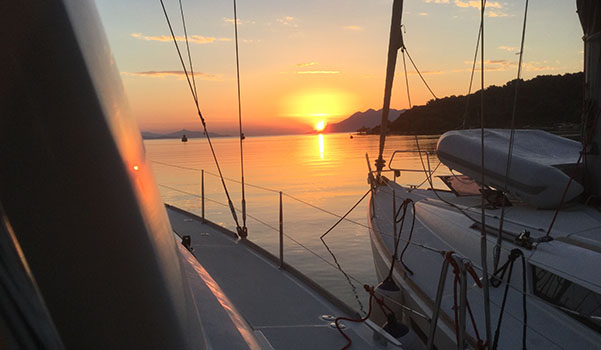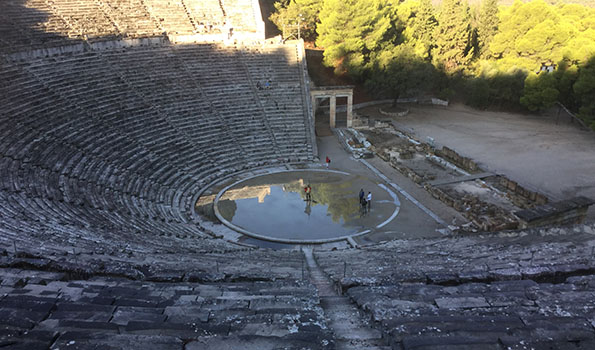Last month I wrote about a sailing trip that Tom (a co-worker at OCSC Sailing in the Berkley Marina) and I led in Greece last September.

The point of land that encloses the harbor at Ermioni, seen to the right of the sunset, was covered with a lovely pine forest and laced with walking paths.
By Captain Ray
Published: February, 2016
Last month I wrote about a sailing trip that Tom (a co-worker at OCSC Sailing in the Berkley Marina) and I led in Greece last September. That column ended as we were leaving Plaka, a very small harbor on the Peloponnese, in search of shelter from an approaching storm.
Our next stop was scheduled to be the island of Hydra (also spelled Idra). That island is very popular because the residents there have banned motorized travel. (Well, almost—their ambulance is a golf cart and the garbage truck is a diesel. But everything else moves at the pace of a donkey or a pushcart.) Because of the island’s popularity, Hydra’s small harbor is often very crowded with visiting yachts, frequently moored three and four deep. With the impending bad weather, we chose instead to go to Ermioni, a more protected and hopefully less crowded harbor about eight miles away.
When Tom and I arrived, we found the quay completely empty and Mediterranean moored. This technique is quite common in the small harbors of the Mediterranean because it places the boat perpendicular to the dock, with an anchor off the bow and lines from the stern to the dock. This allows many more boats to use the same dockspace. In anticipation of the approaching foul weather, we doubled the stern lines and put out 60 meters of chain in four meters of water (20 meters of chain would normally be sufficient). As more and more boats arrived, we assisted them in getting settled in, taking their lines as they docked and helping wherever we could. We then sat back and waited for the storm.
The storm arrived at 8 a.m. the next morning, with winds to 40 knots (about 45 mph), heavy rain and sometimes hail. Our timely arrival and the preparations we made the day before paid off. We rode out the blow in complete safety and comfort. Others were not so fortunate; some later arrivals had to accept less protected areas and one boat lost its anchor. On the other side of the island, several vessels were blown ashore. There was considerable damage (not to any of our boats), but we didn’t hear of anyone being injured.
We ended up spending three very pleasant days at Ermioni, adjusting our outdoor time to the pattern of the rains. This wasn’t very difficult as the wi-fi network of the restaurant at the foot of the quay reached to the boat, and the restaurant also offered a very nice full English breakfast and free showers! The point of land that enclosed the harbor (seen to the right of the sunset in the photo above) was covered with a lovely pine forest and laced with walking paths. Tom and I had been concerned that our crews would miss visiting Hydra, but a ferry to that most attractive island departed directly from the quay we were tied to.
Our next stop was Epidavrous, about 30 miles to the north. The harbor is quite small, with room for about a dozen charter boats, and it was full when we arrived. There is a small anchorage, but that would have meant shuttling everyone back and forth to shore by dinghy. As we were milling about deciding what to do, two boats left and we were able to Mediterranean moor to the seawall. Sometimes you’re just lucky!
In the mountains above the town is the best preserved Greek theater in the world. Built in the fourth century BCE, it seats 14,000 and is still in use today. A 7:30 a.m. taxi pickup avoided the crowds and heat of midday. We all had a wonderful visit to not only the theater itself, but a small museum and the extensive ruins of the asclepeion, the most renowned healing center of the ancient world.
We departed Epidavrous with the intention of one last swim before returning our boat to its Athens base. However, our engine throttle problem reappeared. Two of my crew were able to make a temporary repair, but we decided to return directly to base. We radioed ahead to inform them that the throttle issue had recurred and they sent out two employees to assist with the docking. Then it was showers and a last dinner out.
The next morning, we all went our separate ways—some home, some to catch a ferry to yet another other Greek island, some to additional European destinations. But we all left with memories of a beautiful two weeks of Peloponnesian sailing.
Ray Wichmann, is a US SAILING-certified Ocean Passagemaking Instructor, a US SAILING Master Instructor Trainer, and a member of US SAILING’s National Faculty. He holds a 100-Ton Master’s License, was a charter skipper in Hawai’i for 15 years, and has sailed on both coasts of the United States, in Mexico, the Caribbean and Greece. He is presently employed as the Master Instructor at OCSC Sailing in the Berkeley Marina.

In the mountains above Epidavrous is the best preserved Greek theater in the world. Built in the fourth century BCE, it seats 14,000 and is still in use today.

